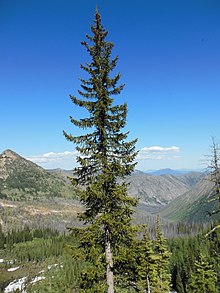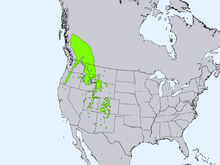
A spruce is a tree of the genus Picea, a genus of about 40 species of coniferous evergreen trees in the family Pinaceae, found in the northern temperate and boreal (taiga) regions of the Earth. Picea is the sole genus in the subfamily Piceoideae. Spruces are large trees, from about 20 to 60 m tall when mature, and have whorled branches and conical form.

Pinus albicaulis, known by the common names whitebark pine, white bark pine, white pine, pitch pine, scrub pine, and creeping pine, is a conifer tree native to the mountains of the western United States and Canada, specifically subalpine areas of the Sierra Nevada, Cascade Range, Pacific Coast Ranges, and Rocky Mountains. It shares the common name "creeping pine" with several other plants.

Picea mariana, the black spruce, is a North American species of spruce tree in the pine family. It is widespread across Canada, found in all 10 provinces and all 3 territories. It is the official tree of the province of Newfoundland and Labrador and is that province's most numerous tree. The range of the black spruce extends into northern parts of the United States: in Alaska, the Great Lakes region, and the upper Northeast. It is a frequent part of the biome known as taiga or boreal forest.
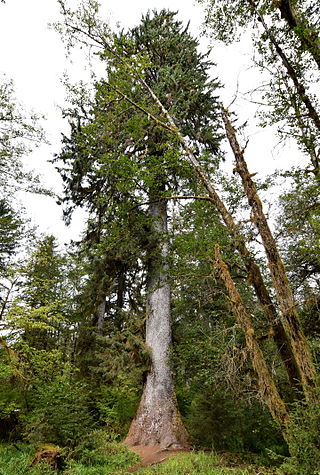
Picea sitchensis, the Sitka spruce, is a large, coniferous, evergreen tree growing to almost 100 meters (330 ft) tall, with a trunk diameter at breast height that can exceed 5 m (16 ft). It is by far the largest species of spruce and the fifth-largest conifer in the world, and the third-tallest conifer species. The Sitka spruce is one of the few species documented to exceed 90 m (300 ft) in height. Its name is derived from the community of Sitka in southeast Alaska, where it is prevalent. Its range hugs the western coast of Canada and the US, continuing south into northernmost California.

Abies grandis is a fir native to northwestern North America, occurring at altitudes of sea level to 1,700 metres (5,600 ft). It is a major constituent of the Grand Fir/Douglas Fir Ecoregion of the Cascade Range.

Abies concolor, the white fir, concolor fir, or Colorado fir, is a coniferous tree in the pine family Pinaceae. This tree is native to the mountains of western North America, including the Sierra Nevada and southern Rocky Mountains, and into the isolated mountain ranges of southern Arizona, New Mexico, and Northern Mexico. It naturally occurs at elevations between 900 and 3,400 metres.
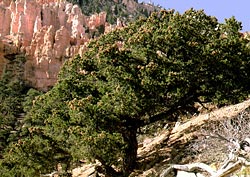
Pinus edulis, the Colorado pinyon, two-needle piñon, pinyon pine, or simply piñon, is a pine in the pinyon pine group native to the Southwestern United States, used for its edible pine nuts.

Tsuga heterophylla, the western hemlock or western hemlock-spruce, is a species of hemlock native to the west coast of North America, with its northwestern limit on the Kenai Peninsula, Alaska, and its southeastern limit in northern Sonoma County, California. The Latin species name means 'variable leaves'.

Tsuga mertensiana, known as mountain hemlock, is a species of hemlock native to the west coast of North America, found between Southcentral Alaska and south-central California.

Picea breweriana, known as Brewer spruce, Brewer's weeping spruce, or weeping spruce, is a species of spruce native to western North America, where it is one of the rarest on the continent. The specific epithet breweriana is in honor of the American botanist William Henry Brewer.

Picea rubens, commonly known as red spruce, is a species of spruce native to eastern North America, ranging from eastern Quebec and Nova Scotia, west to the Adirondack Mountains and south through New England along the Appalachians to western North Carolina. This species is also known as yellow spruce, West Virginia spruce, eastern spruce, and he-balsam. Red spruce is the provincial tree of Nova Scotia.

The blue spruce, also commonly known as green spruce, Colorado spruce, or Colorado blue spruce, is a species of spruce tree native to North America in Arizona, Colorado, Idaho, New Mexico, Utah and Wyoming. It is noted for its blue-green colored needles, and has therefore been used as an ornamental tree in many places far beyond its native range.

Picea jezoensis, the dark-bark spruce, Ezo spruce, Yezo spruce, or Jezo spruce, is a large evergreen tree growing to 30–50 m tall and with a trunk diameter of up to 2 m. It is native to northeast Asia, from the mountains of central Japan and the Changbai Mountains on the China-North Korea border, north to eastern Siberia, including the Sikhote-Alin, Kuril Islands, Sakhalin and Kamchatka. It is found in cold but humid temperate rain forests, and nowhere does its range extend more than 400 km from the Pacific Ocean. The specific epithet jezoensis derives from Ezo, an old name for Hokkaido and other islands north of the Japanese island of Honshu, where the species is found.

Picea martinezii, the Martinez spruce, is a medium-sized evergreen tree growing to 25–35 m tall, and with a trunk diameter of up to 1 m. It is native to northeast Mexico, where it occurs at six localities in the Sierra Madre Oriental mountains in Nuevo León. It grows at moderate altitudes from 2150–2600 m, growing along streamsides in mountain valleys, where moisture levels in the soil are greater than the otherwise low rainfall in the area would suggest.
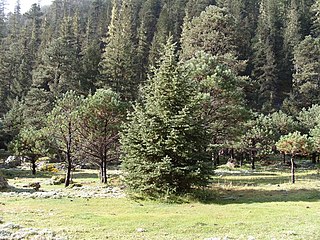
Picea chihuahuana, the Chihuahua spruce, is a medium-sized evergreen tree growing to 25–35 m tall, and with a trunk diameter of up to 1 m. It is native to northwest Mexico, where it occurs in 25 small populations in the Sierra Madre Occidental mountains in Chihuahua and Durango. It grows at moderate altitudes from 2300–3200 m, growing along streamsides in mountain valleys, where moisture levels in the soil are greater than the otherwise low rainfall in the area would suggest.

The Fraser fir, sometimes spelled Frasier fir, is an endangered species of fir native to the Appalachian Mountains of the Southeastern United States. They are endemic to only seven montane regions in the Appalachian Mountains.

Abies lasiocarpa, the subalpine fir or Rocky Mountain fir, is a western North American fir tree.

Abies amabilis, commonly known as the Pacific silver fir, is a fir native to the Pacific Northwest of North America, occurring in the Pacific Coast Ranges and the Cascade Range. It is also commonly referred to in English as the white fir, red fir, lovely fir, amabilis fir, Cascades fir, or silver fir. The species name is Latin for 'lovely'.

Abies vejarii is a species of fir native to northeastern Mexico, in the states of Coahuila, Nuevo León, and Tamaulipas, where it grows at high altitudes in the Sierra Madre Oriental.
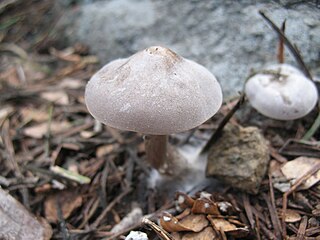
A snowbank fungus is any one of a number of diverse species of fungi that occur adjacent to or within melting snow. They are most commonly found in the mountains of western North America where a deep snowpack accumulates during the winter and slowly melts through the spring and summer, often shaded by coniferous forest. They may be saprotrophic, mycorrhizal, or in the case of Caloscypha fulgens, pathogenic.
